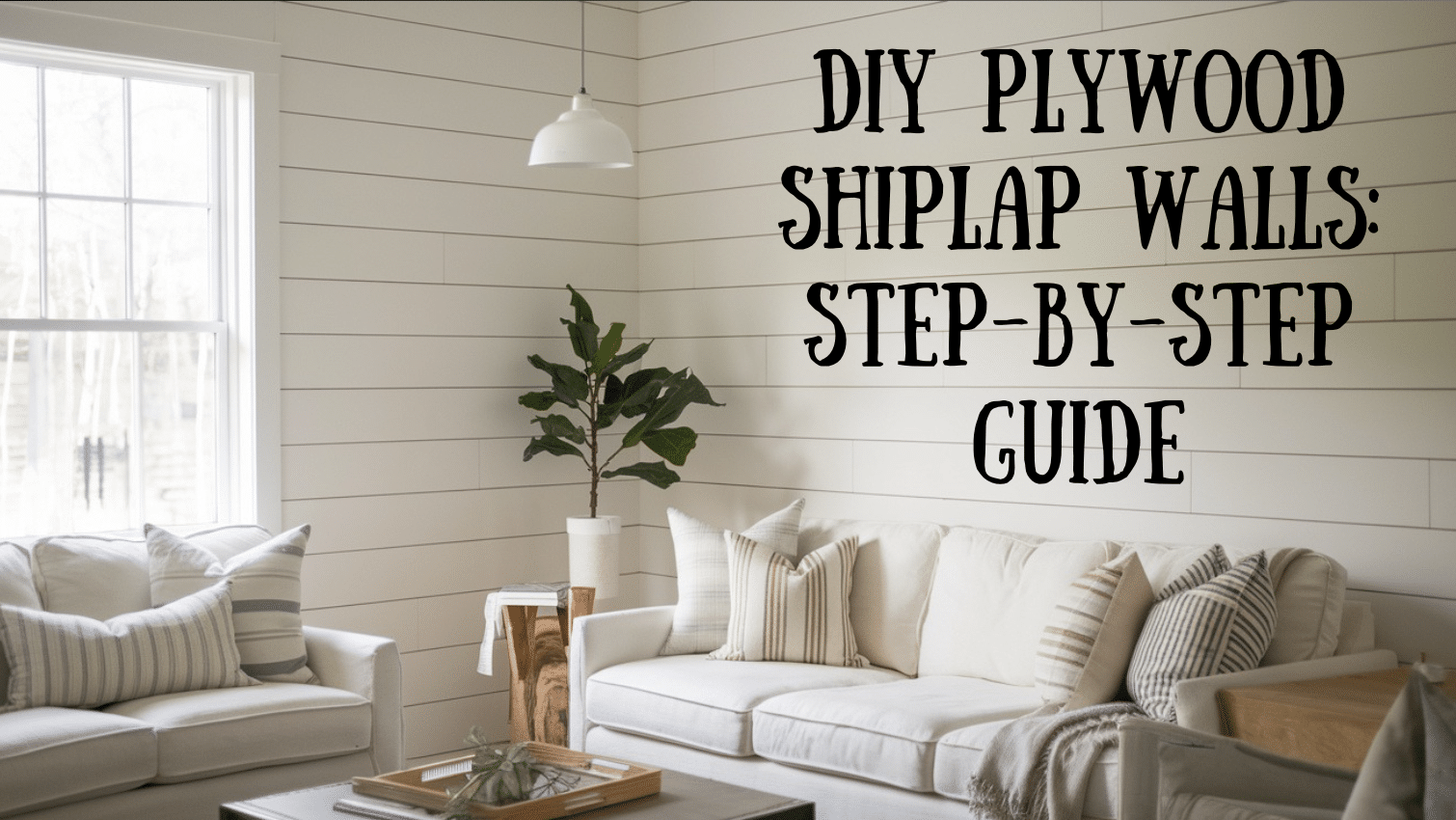Have you ever looked at your plain walls and wished they had more personality?
I get it – most of us want beautiful walls, but traditional wood paneling costs a fortune. Plus, hiring professionals can blow your budget sky-high.
Between material costs and labor fees, a simple wall upgrade can turn into a wallet-draining project.
But here’s the good news: You can create stunning plywood shiplap walls yourself for a fraction of the cost.
I’ll show you how to transform your walls using basic tools and materials from your local hardware store.
No special skills are needed—just follow my simple steps, and you’ll have gorgeous walls that look like they cost thousands.
What Is Plywood Shiplap?
It’s a wall covering made from plywood sheets cut into planks that overlap slightly at the edges.
Think of it as a cousin to traditional wood planks, but much more wallet-friendly.
Why choose plywood for your walls? Well, I’ve found three main reasons my readers love it:
- It’s budget-smart: Plywood costs way less than solid wood boards
- It’s light and easy to handle: You won’t need extra help to lift and place the pieces
- It’s simple to cut and install: Basic tools from your garage will do the job
Plywood shiplap works great in any room. I’ve seen beautiful results in living rooms, bedrooms, and even accent walls in home offices. The key is picking the right type of plywood for your space.
Tools and Materials You’ll Need
| Category | Item | Specification | Purpose |
|---|---|---|---|
| Essential Tools | Measuring Tape | 16-25 feet long | Measure wall dimensions for precise cuts. |
| Circular/Table Saw | 7 1/4″ blade | Cut plywood sheets into uniform planks. | |
| Level | 24″ or 48″ | Ensure planks are straight during installation. | |
| Drill | Cordless, 18V+ | Create pilot holes and secure screws. | |
| Sanding Block/Sander | 120-220 grit | Smooth plywood edges and surfaces. | |
| Spacers | 1/8″ to 1/4″ thick | Maintain even gaps between planks. | |
| Materials | Plywood Sheets | 1/4″-3/8″ thick, 4’x8′ panels | Base material for shiplap planks. |
| Nails/Screws | 1 1/4″ to 1 1/2″ length | Secure planks to the wall. | |
| Paint or Stain | Sufficient for wall area | Finish planks in the desired color or style. | |
| Caulk/Wood Filler | Paintable, shrink-resistant | Fill gaps and nail holes for a seamless look. | |
| Trim or Molding | 1″ to 3″ wide | Add a polished finishing touch to the edges. |
A quick tip from my experience: Buy about 10% more plywood than you think you need. This gives you room for mistakes and tricky cuts around outlets or corners.
Make Your Plywood Shiplap: 5 Simple Steps
Step 1: Gather Your Tools and Materials
Before starting your plywood shiplap wall project, you must collect all your tools and supplies.
Safety comes first, so prepare your protective gear: a dust mask, ear protection, and safety glasses.
Don’t forget some clamps to hold things in place while cutting.
Step 2: Cut Your Plywood
The cutting process starts with careful marking on your plywood sheets.
Mark the sheet at 7-inch intervals, adding 1.5 inches to each mark. This extra space is for your saw guide placement.
Place your straight edge along these marks to guide your cuts. To save time, stack multiple sheets together and cut them all simultaneously.
Before cutting, set your blade depth through all the plywood layers but not too deep into your backing board. When cutting, apply steady pressure and let the saw do the work – don’t force it.
Step 3: Start Installation
Begin the installation by measuring your wall width precisely. Cut your first piece to match this width.
This first board is crucial. Grab your level and position it carefully. Here’s a key tip: don’t trust your floor to be level.
It’s better to slightly place the first piece on one side if necessary, as you can cover any gaps with trim later.
Once the board is positioned correctly, secure it into the wall studs with a nail gun set at about 100 PSI.
Ensure this first piece is perfectly level, as it will serve as the foundation for all other boards.
Step 4: Continue the Pattern
After your first board is secure, the pattern begins. Place nickels between the boards as spacers – this creates the perfect gap for that shiplap look.
A key technique is staggering the seams across wall studs, which adds strength and improves appearance.
When you need to cut pieces to meet at wall studs, make sure they extend at least halfway onto the stud for proper support.
Keep checking your level as you work up the wall. For outlets, measure carefully – typically 4 inches from the edges – and mark your cuts precisely.
Step 5: Complete the Wall
The final phase of installation requires the same attention to detail as when you started. Keep using those nickel spacers between each board to maintain consistent gaps.
Continue your pattern of staggered seams across the studs – this prevents obvious vertical lines in your finished wall.
You must cut your final piece to fit the remaining space when you reach the top.
If you plan to paint, wait until all boards are securely installed. Finally, add trim pieces around the edges for a clean, finished look.
Nail into studs and keep the trim level with your shiplap pattern.
Watch Bearded Spruce’s detailed step-by-step video guide on YouTube to see exactly how to create stunning DIY plywood shiplap walls!
Maintenance and Care Tips for Plywood Shiplap
Keep your plywood shiplap walls beautiful and long-lasting with these easy tips:
Regular Cleaning
- Use a soft cloth or duster for light cleaning every few weeks.
- For deeper cleaning, use a slightly damp cloth and dry immediately.
- Avoid letting water sit on the surface.
Preventing Moisture Issues
- Ensure proper ventilation in bathrooms or damp areas.
- Run exhaust fans during showers and for 30 minutes afterward.
- Dry water spots quickly to avoid staining.
Maintaining Painted Shiplap
- Inspect for chips or peeling paint annually.
- Touch up small areas with leftover paint for quick fixes.
High-Moisture Protection
- Apply a clear sealant for added humidity resistance.
- Sealant helps maintain a fresh and polished look.
- By following these simple steps, your shiplap walls will stay in great shape with minimal effort!
Conclusion
Building plywood shiplap walls takes some time, but the results speak for themselves.
With basic tools, careful measurements, and step-by-step work, you can build walls that look like they cost thousands without the big price tag.
Remember, the keys to success are simple: level your first board perfectly, keep spacing even with those nickels, and take your time with the cuts.
Even if you’re new to DIY projects, this method allows you to create beautiful walls yourself.
I hope this guide shows you how simple and satisfying it is to make your own plywood shiplap.
With proper care and maintenance, your walls will look wonderful for years to come.
Frequently Asked Questions
Can I Use Plywood to Make Shiplap?
Yes, plywood makes an excellent material for shiplap walls. When cut into strips and installed with small gaps between boards, plywood creates the same look as traditional shiplap at a much lower cost.
Is Shiplap Cheaper than Plywood?
It’s the opposite —plywood is much cheaper than traditional shiplap. Traditional shiplap boards can cost $7-12 per square foot, while plywood shiplap typically costs $2-4 per square foot.
Is There a Cheaper Alternative to Shiplap?
Plywood strips are the most budget-friendly choice. However, you can also use MDF boards, vinyl planks, or beadboard panels to achieve a similar look for less.
What Is the New Trend Instead of Shiplap?
Board and batten have become popular wall treatments in today’s homes, along with textured wallpaper and wood slat walls.


